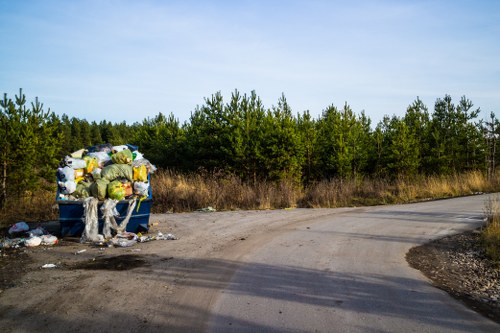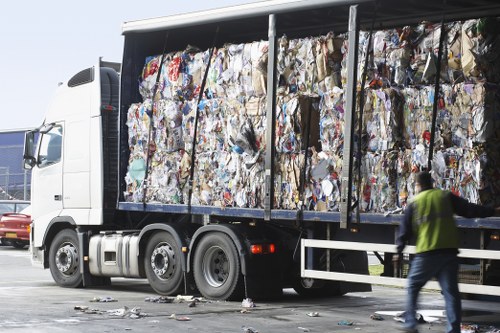Site Clearance in Poplar: Your Comprehensive Guide

**Site clearance** is a crucial first step in any construction or development project. In Poplar, a vibrant and rapidly growing area, effective site clearance ensures that projects begin smoothly and adhere to local regulations. Whether you're planning a residential build, commercial development, or landscaping project, understanding the nuances of site clearance in Poplar is essential for success.
Poplar, located in the heart of London, has seen significant development over the past few years. With its rich history and modern amenities, it attracts both residential and commercial projects. However, before any construction can commence, site clearance must be meticulously planned and executed.
This guide provides an in-depth look at the site clearance process in Poplar, covering everything from initial planning and permits to the actual clearance work and post-clearance considerations.

Understanding Site Clearance
Site clearance involves the removal of existing structures, vegetation, debris, and any other obstacles that may impede new construction. It sets the foundation for a safe and efficient building process. Proper site clearance not only ensures compliance with local laws but also minimizes risks during construction.
In Poplar, site clearance must account for the area's unique characteristics, including its urban environment, historical buildings, and environmental considerations. Navigating these factors requires expertise and familiarity with local regulations.
**Key aspects of site clearance include:
- Demolition of existing structures
- Removal of vegetation and landscaping
- Debris and waste management
- Site grading and leveling
- Ensuring environmental compliance

Planning for Site Clearance in Poplar
Effective site clearance begins with comprehensive planning. This phase involves assessing the site, obtaining necessary permits, and developing a clear strategy for the clearance process.
Site Assessment
Before any physical work begins, a thorough site assessment is essential. This involves evaluating the current state of the land, identifying any potential hazards, and determining the scope of work needed.
Factors to consider during the site assessment include:
- **Topography:** Understanding the land's elevation and slope to plan for grading.
- **Existing Structures:** Identifying buildings or other structures that need demolition or relocation.
- **Vegetation:** Assessing the type and extent of vegetation to be removed.
- **Utilities:** Locating and safely disconnecting existing utilities like water, gas, and electricity.
- **Environmental Impact:** Evaluating potential effects on local ecosystems and planning mitigation strategies.

Regulatory Requirements in Poplar
Poplar, being part of London, is subject to a range of local and national regulations governing site clearance. Compliance with these regulations is non-negotiable and ensures that the project proceeds without legal complications.
Permits and Approvals
Obtaining the necessary permits is a fundamental step in the site clearance process. Some of the key permits required include:
- **Demolition Permits:** Required for the safe removal of existing structures.
- **Environmental Permits:** Necessary if the clearance activities impact local wildlife or waterways.
- **Planning Permissions:** Ensures that the proposed clearance and subsequent construction align with local planning guidelines.
Engaging with the local council early in the process can help streamline the permit acquisition process and address any potential issues proactively.
Environmental Regulations
Environmental protection is a significant concern in site clearance. Regulations aim to minimize the environmental footprint of clearance activities. Key considerations include:
- **Waste Management:** Proper disposal and recycling of materials to reduce landfill use.
- **Dust Control:** Implementing measures to reduce airborne dust and protect air quality.
- **Noise Reduction:** Managing noise levels to minimize disturbance to the local community.
- **Erosion Control:** Preventing soil erosion during site grading and landscaping.

The Site Clearance Process
The site clearance process in Poplar can be broken down into several key stages:
1. Site Preparation
Preparing the site involves securing the area, setting up safety measures, and ensuring that all necessary equipment is in place. This stage lays the groundwork for efficient and safe clearance activities.
2. Demolition
Demolition is often the most visible part of site clearance. It requires careful planning to safely dismantle structures without causing collateral damage. Specialized equipment and trained personnel are essential for this phase.
3. Vegetation Removal
Removing trees, shrubs, and other vegetation is necessary to create a clean slate for construction. This step must be carried out responsibly, especially in areas with protected or endangered plant species.
4. Debris and Waste Management
Efficiently managing debris and waste is crucial for maintaining site cleanliness and complying with environmental regulations. Materials should be sorted for recycling or proper disposal.
5. Site Grading and Leveling
Once clearance is complete, the site may need grading and leveling to ensure a stable foundation for future construction. This involves adjusting the land to the desired contours and elevations.

Choosing the Right Site Clearance Contractor
Selecting a reputable and experienced site clearance contractor is vital for the success of your project. A professional contractor will ensure that all aspects of clearance are handled efficiently and in compliance with local regulations.
Key Considerations
When choosing a site clearance contractor in Poplar, consider the following factors:
- **Experience:** Look for contractors with a proven track record in site clearance within Poplar or similar areas.
- **Licensing and Insurance:** Ensure the contractor holds the necessary licenses and insurance to protect against potential liabilities.
- **Equipment and Resources:** A well-equipped contractor can handle various clearance tasks effectively.
- **References and Reviews:** Check testimonials and reviews to gauge the contractor's reliability and quality of work.
- **Cost Estimates:** Obtain detailed quotes to understand the financial aspects and ensure they fit within your budget.
Benefits of Hiring Professionals
Hiring a professional site clearance contractor offers numerous advantages:
- **Efficiency:** Professionals can complete clearance tasks more quickly and accurately.
- **Safety:** Experienced contractors follow safety protocols to prevent accidents and injuries.
- **Compliance:** Ensures all activities meet local regulations and environmental standards.
- **Quality:** Professional workmanship results in a well-prepared site for subsequent construction.

Cost Factors in Site Clearance
The cost of site clearance can vary significantly based on several factors. Understanding these can help you budget effectively and avoid unexpected expenses.
Size and Scope of the Project
The larger and more complex the site, the higher the cost. Factors include the total area to be cleared, the number and size of existing structures, and the amount of vegetation present.
Access to the Site
Sites that are difficult to access may require specialized equipment or additional labor, increasing costs. Urban areas like Poplar may present unique access challenges compared to rural locations.
Type of Materials to be Removed
The nature of the materials being cleared can impact costs. Demolishing concrete structures or removing large trees requires more resources and time than clearing simpler vegetation or debris.
Environmental Considerations
Sites with protected species or sensitive ecosystems may necessitate additional measures to comply with environmental regulations, adding to the overall cost.
Permitting and Regulatory Fees
Obtaining the necessary permits and adhering to regulatory requirements can also affect the total cost. These fees vary based on the project's specifics and local laws.

Environmental Impact of Site Clearance
Site clearance can have significant environmental implications. Responsible practices are essential to minimize negative impacts and promote sustainability.
Sustainable Practices
Implementing sustainable clearance practices helps protect the environment and aligns with local regulations. Key strategies include:
- **Recycling Materials:** Salvaging and recycling materials like metal, wood, and concrete reduces landfill waste.
- **Erosion Control:** Using barriers and vegetation to prevent soil erosion during and after clearance.
- **Wildlife Protection:** Implementing measures to protect local wildlife habitats from disruption.
- **Dust and Noise Management:** Employing techniques to minimize dust and noise pollution during clearance activities.
Mitigating Environmental Risks
To mitigate environmental risks, consider the following:
- **Environmental Assessments:** Conduct thorough assessments to identify potential environmental impacts before beginning clearance.
- **Compliance with Regulations:** Adhere strictly to environmental laws and guidelines to prevent legal issues and environmental damage.
- **Post-Clearance Restoration:** Engage in site restoration activities, such as planting native vegetation, to restore the ecosystem after clearance.
Benefits of Eco-Friendly Site Clearance
Adopting eco-friendly site clearance practices offers multiple benefits:
- **Reduced Environmental Footprint:** Minimizes the impact on local ecosystems and biodiversity.
- **Cost Savings:** Recycling materials can lower disposal costs and provide materials for future use.
- **Enhanced Community Relations:** Demonstrates a commitment to environmental stewardship, building trust with the local community.
- **Regulatory Compliance:** Ensures adherence to environmental laws, avoiding fines and project delays.

Post-Clearance Considerations
After site clearance, several steps are necessary to prepare the site for construction. These include site grading, soil testing, and ensuring all clearance activities have met regulatory standards.
Site Grading and Preparation
Proper grading ensures a stable foundation for construction. It involves adjusting the land to the desired elevation and slope, preventing future drainage issues and providing a level base for building structures.
Soil Testing
Conducting soil tests helps identify any contaminants or issues that need to be addressed before construction begins. This step ensures the safety and integrity of the building process.
Final Inspections
Before moving forward with construction, final inspections by local authorities ensure that all site clearance activities comply with regulations and that the site is ready for the next phase of development.
Documentation and Record-Keeping
Maintaining thorough documentation of the site clearance process is crucial for accountability and future reference. This includes records of permits, environmental assessments, and clearance activities.

Common Challenges in Site Clearance
Site clearance projects often encounter various challenges. Being aware of these potential issues can help in planning and mitigating their impact.
Unforeseen Obstacles
Unexpected structures or underground utilities can complicate the clearance process. Conducting a thorough site assessment can help identify and address these obstacles early on.
Weather Conditions
Adverse weather can delay clearance activities and affect the quality of work. Planning for weather contingencies ensures that the project stays on track.
Regulatory Hurdles
Navigating complex regulations can be time-consuming and require expertise. Working with knowledgeable contractors and legal advisors can streamline this process.
Budget Overruns
Unexpected costs can strain the project budget. Detailed planning and contingency funds can help manage and mitigate financial risks.

Case Studies: Successful Site Clearance in Poplar
Examining successful site clearance projects in Poplar provides valuable insights and best practices. These case studies highlight effective strategies and common pitfalls to avoid.
Residential Development Project
A recent residential development in Poplar required extensive site clearance, including the demolition of a historical building. By engaging experienced contractors and conducting a detailed environmental assessment, the project stayed on schedule and adhered to all regulations.
Commercial Complex Clearance
A large commercial complex required the removal of significant vegetation and debris. Utilizing sustainable practices, the contractors recycled a majority of the materials, reduced waste, and minimized the environmental impact, setting a benchmark for future projects.
Urban Landscaping Project
An urban landscaping initiative in Poplar involved clearing a derelict site for a new park. Careful planning and community engagement ensured that the project met local needs while preserving essential green spaces.

Future Trends in Site Clearance
The field of site clearance is continually evolving, with new technologies and practices emerging to enhance efficiency and sustainability.
Advanced Machinery and Equipment
The adoption of advanced machinery, such as robotic demolition tools and eco-friendly waste processors, is revolutionizing site clearance. These technologies improve precision, reduce manual labor, and minimize environmental impact.
Eco-Friendly Clearance Techniques
There is a growing emphasis on sustainable clearance methods. Techniques like selective demolition, which preserves valuable materials, and green waste recycling are becoming standard practices.
Integrated Project Management Software
Modern project management software allows for better coordination and tracking of site clearance activities. These tools enhance communication, improve scheduling, and ensure that all aspects of the project are aligned.
Emphasis on Safety and Compliance
As regulations become more stringent, there is an increased focus on safety and compliance in site clearance. Contractors are investing in training and safety technologies to meet these demands.

Choosing the Right Time for Site Clearance
Timing plays a critical role in the success of site clearance. Selecting the optimal time ensures that the process is efficient and minimizes disruptions.
Seasonal Considerations
Different seasons present unique challenges and opportunities for site clearance. For example, spring and summer offer favorable weather conditions, while winter may pose logistical difficulties.
Project Timeline Coordination
Aligning site clearance with the overall project timeline is essential. Delays in clearance can have a ripple effect, impacting subsequent construction phases.
Community Impact
Scheduling clearance activities during times that cause minimal disruption to the local community fosters goodwill and reduces complaints. Engaging with the community to understand their concerns can guide scheduling decisions.

Cost-Saving Strategies in Site Clearance
Effective cost management is vital in site clearance. Implementing strategic approaches can help reduce expenses without compromising quality.
Efficient Project Planning
Detailed planning minimizes unexpected costs by anticipating potential challenges and addressing them proactively. Clear timelines and resource allocation contribute to cost-efficiency.
Recycling and Reuse
Recycling materials not only supports sustainability but also reduces disposal costs. Reusing materials where possible can further lower expenses.
Bulk Hiring and Negotiation
Engaging contractors and suppliers for multiple projects or negotiating bulk rates can lead to significant cost savings.
Technology Integration
Utilizing technology for project management and operational efficiency can streamline processes and reduce labor costs.

Safety Practices in Site Clearance
Ensuring safety during site clearance is paramount. Adhering to safety protocols protects workers, minimizes accidents, and maintains project integrity.
Comprehensive Training
Providing ongoing training for workers ensures they are knowledgeable about safety procedures and equipped to handle potential hazards.
Protective Equipment
Using appropriate protective gear, such as helmets, gloves, and safety goggles, reduces the risk of injuries during clearance activities.
Regular Safety Inspections
Conducting regular safety inspections helps identify and mitigate risks promptly. This proactive approach maintains a safe working environment.
Emergency Preparedness
Having clear emergency plans and readily accessible first aid resources ensures that any incidents are managed effectively and swiftly.

Conclusion: Achieving Success with Site Clearance in Poplar
**Site clearance** in Poplar is a multifaceted process that requires careful planning, adherence to regulations, and the expertise of qualified professionals. By understanding the various stages, challenges, and best practices, you can ensure a smooth and efficient clearance process, laying a solid foundation for your construction or development project.
**Contact us today** to learn more about our site clearance services in Poplar and how we can help you achieve your project goals with efficiency and compliance.
**Book your service now** and take the first step towards successful site development in Poplar.